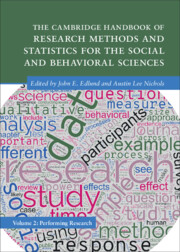 The Cambridge Handbook of Research Methods and Statistics for the Social and Behavioral Sciences
The Cambridge Handbook of Research Methods and Statistics for the Social and Behavioral Sciences Book contents
- The Cambridge Handbook of Research Methods and Statistics for the Social and Behavioral Sciences
- Cambridge Handbooks in Psychology
- The Cambridge Handbook of Research Methods and Statistics for the Social and Behavioral Sciences
- Copyright page
- Dedication
- Contents
- Figures
- Tables
- Contributors
- Preface
- Part I Quantitative Data Collection Sources
- Part II Important Methodological Considerations
- Part III Self-Report Measures
- Part IV Behavioral Measures
- Part V Physiological Measures
- 19 Measuring Hormones: Considerations for Biospecimen Collection, Assay, and Analysis
- 20 Cardiovascular Measures for Social and Behavioral Research
- 21 Electrodermal Activity: Applications and Challenges
- 22 Surface Electromyography
- 23 EEG and ERP
- Part VI Qualitative Data Collection Sources
- Index
- References
21 - Electrodermal Activity: Applications and Challenges
from Part V - Physiological Measures
Published online by Cambridge University Press: 12 December 2024
- The Cambridge Handbook of Research Methods and Statistics for the Social and Behavioral Sciences
- Cambridge Handbooks in Psychology
- The Cambridge Handbook of Research Methods and Statistics for the Social and Behavioral Sciences
- Copyright page
- Dedication
- Contents
- Figures
- Tables
- Contributors
- Preface
- Part I Quantitative Data Collection Sources
- Part II Important Methodological Considerations
- Part III Self-Report Measures
- Part IV Behavioral Measures
- Part V Physiological Measures
- 19 Measuring Hormones: Considerations for Biospecimen Collection, Assay, and Analysis
- 20 Cardiovascular Measures for Social and Behavioral Research
- 21 Electrodermal Activity: Applications and Challenges
- 22 Surface Electromyography
- 23 EEG and ERP
- Part VI Qualitative Data Collection Sources
- Index
- References
Summary
Electrodermal activity (EDA) is a conductance measure that can be used to assess the sympathetic nervous system arousal and for the diagnosis of stress, pain, sleepiness, seizure prediction, neuropathies, depression, and other states. EDA has potential for ambulatory research applications, as it can be collected using wearable devices, but motion artifacts are an issue. While EDA was discovered in 1879 by Vigouroux, the signal was traditionally observed in most of the studies as the mean value of the signal in response to a given stimulus, which provides static information but does not account for time-varying dynamics of the signal. The new technologies for EDA collection and the development of novel and robust signal processing algorithms have increased the interest in EDA for many new and emerging fields, including affective computing, seizure prediction, and pain monitoring. We aim to summarize the characteristics of EDA, describe current and future applications, and outline challenges when using EDA.
Information
- Type
- Chapter
- Information
- The Cambridge Handbook of Research Methods and Statistics for the Social and Behavioral SciencesVolume 2: Performing Research, pp. 475 - 496Publisher: Cambridge University PressPrint publication year: 2024
References
Accessibility standard: Unknown
Why this information is here
This section outlines the accessibility features of this content - including support for screen readers, full keyboard navigation and high-contrast display options. This may not be relevant for you.Accessibility Information
- 1
- Cited by